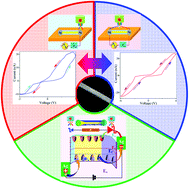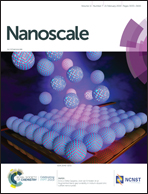Tunable hysteresis behaviour related to trap filling dependence of surface barrier in an individual CH3NH3PbI3 micro/nanowire
Abstract
Hybrid organic–inorganic perovskite (HOIP) materials have remarkable potential in solar cells owing to their high power conversion efficiency and inexpensive preparation. However, their current–voltage (I–V) curves often exhibit hysteresis characteristics, which not only strongly affect the accuracy of measurements but also seriously impair device performance, and, moreover, their actual origin is still the subject of debate. Here, a single HOIP micro/nanowire-based two-terminal device was constructed. Not only can its hysteresis properties be accurately modulated, but also their origin can clearly be identified as variations in the surface barrier related to trap filling. Under illumination of the entire device with visible (VIS) light, two anticlockwise hysteresis loops appear symmetrically in cyclic I–V curves. Interestingly, the cyclic I–V curves can be switchably changed into asymmetrical “8”-shaped hysteresis loops with bipolar resistive switching (RS) features when only the vicinity of one electrode is illuminated. The traps located in the surface space charge region play a crucial role in the tunable hysteresis behaviour. Owing to the presence of abundant surface states, two back-to-back connected diodes related to the surface barrier can be formed in the two-terminal device. With the synergistic assistance of illumination and bias, moreover, the injection and extraction of holes in the surface space charge region can effectively modulate the surface barrier, which triggers the formation of a bipolar RS device. Accordingly, two switchable back-to-back connected bipolar RS devices were built. Regarding the tunable hysteresis with nonvolatile memory properties controlled by the synergistic action of bias and illumination, our results provide a valuable insight into the identification of its origin and, furthermore, also indicate that the HOIP materials have significant potential in nonvolatile memory applications.



 Please wait while we load your content...
Please wait while we load your content...